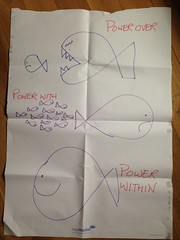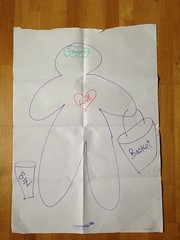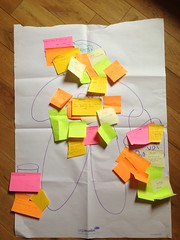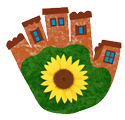This tutorial gives you a very compressed starting help to get into the development of community based projects. Attached to this tutorial is a workshop plan which might serve you as a guideline when starting a community based project.
The tutorial is a collaborative work from Shan Ashton and Christine Graf.
What is special about community based projects?
 people are always at the centre
people are always at the centre- it is about people as social beings
- working and learning together
- collective action / shared workload
- inclusive, anti-discriminatory practice with equality at the core
- working in such a way generates the possibility of community and personal empowerment
How to engage people in community projects / how to begin community projects?
- create an environment & use tools where people can communicate, share and participate
- clarify / discover / develop how people communicate with each other
- focus on things that matter to people now....and work on the links to other issues
- be solutions focused but keep a close eye on the process
- have fun!!!
How to develop and sustain community projects?
Local sustainability is THE goal of any community-based project.
To ensure sustainability of the projects and it's impacts it is necessary to achieve a common understanding of the community project approach between all participants. This includes a clear definition of responsibilities and scheduled actions which surpass the project period.
Among all, you need to balance the interests, needs and barriers of all participants and prioritize actions accordingly. As the community building process is agile, your working methods should also be flexible enough to allow adaptation of new ideas, tools and methods and react to changing conditions.
 There are a lot of methods to find out topics of common interest and initiate action, e.g. the problem tree.
There are a lot of methods to find out topics of common interest and initiate action, e.g. the problem tree.
Draw a tree with the problem as the trunk, the possibilities you have to solve it as the branches and the sources of the problems as roots.
Only if you really find out the roots of a problem you will be able to think of actions to solve it.
This might be very different to what you already tried.
Maintain communication
You need to think about a communication strategy from the early beginning, to share, attract people and raise attention. Don't be afraid that someone could "steal" your ideas: make them public to let them grow and develop, let them be copied by others, you will get a lot of information and inspiration back which might be helpful for the development of your projects too.
When choosing communication tools, think of your audience and what do you want to transmit.
There are the classical one-way communication tools to inform your audience, members, etc., such as radio, TV, flyer, poster, newsletter.
Interactive communication tools like Twitter, Facebook, surveys (online, offline) telephone, from kitchen-to-kitchen, events are perfect to get in feedback, opinions, ideas and inspiration.
- express own reflections and ideas clearly
- develop relationships
- provide feedback (answers, reacts) and be open to others’ feedback without prejudice, references etc.
- respect attitudes and opinions of others
- be tolerant to different customs and cultures
Develop networks & partnerships
A network is a group of individuals and/or organisations that are linked together for mutual interest. They can be formal (set up with a constitution and designated roles and actions) or informal (simple in formation and practice) and can be established in a variety of ways.
The common feature of all networks, whatever their form, is that they are about relationships and are as much about what you can contribute as about what you can take from the network. Networking is about far more than attending a networking event and shaking hands, it's about being proactive in terms of learning, sharing, contributing, gaining.
Develop action plans
A concise and effective action plan serves as a map to achieve your goals and enables group members to take the straightest road possible toward that goal. An action plan helps you to follow your "red line" and to improve and to reflect on what was already done.
There are several templates available, at least it should list the following:
- Date
- Activity (tasks)
- Who is/what kind of resources are needed?
- Planned outcome
- By When?
- Review / completion comments
Measure success / learning/results/activities

 People measure success in different ways and levels.
People measure success in different ways and levels.
You need to define at the beginning when you count an action successful, what is your benefit of being successful.
Being successful does not only mean that you count numbers and things, that you had fun but also if you created value for others.
The example for measuring we give you is the evaluation buddy:
- what ideas, thoughts you got?
- what did you love?
- what you did not love?
- what do you take home?
Celebrate success / learning / results / activities
Recognizing contributions from people and what has been achieved is good for the morale and spirit of the group.
Celebrate regularly, even small achievements to keep to motivation, to reflect on what was done and how you did it, to get feedback and new inspiration, to raise public attention.
Have fun together!



Recent comments